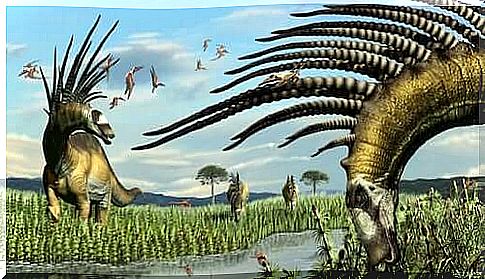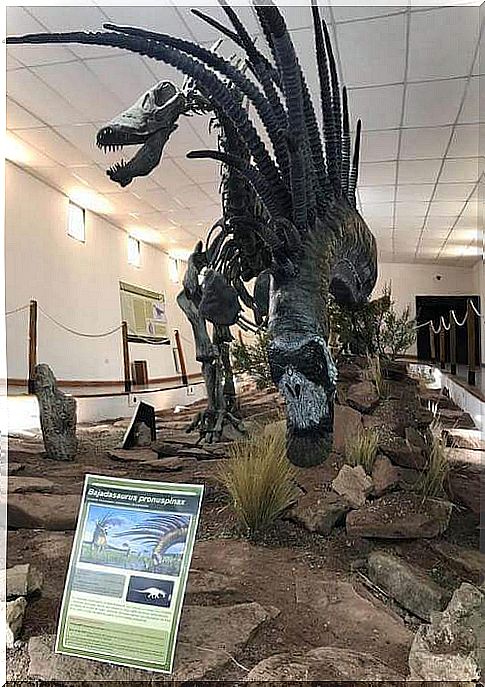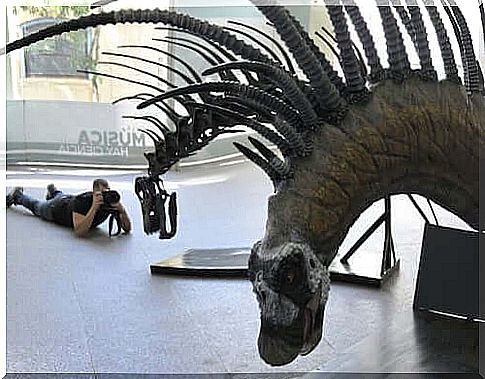The Remains Of Dinosaurs With Giant Thorns Found In Patagonia

A new species of herbivorous dinosaur has been discovered in Patagonia. The remains found show that 140 million years ago there was a species of dinosaur with giant spines that lived in the southern regions of Argentina.
Those responsible for the discovery are the scientists of the Fundación Azara – Universidad de Maimónides and of the CONICET (National Council for Scientific and Technical Research of Argentina). These would be large reptiles with long spines that they used to defend themselves from attacks by predators.
General characteristics of dinosaurs with giant spines
The characteristics of Bajadasaurus pronuspinax were described in an article published in Scientific Reports. The skeletal remains allow us to classify this dinosaur in the group of sauropods. The new specimen is said to be a relative of the aragosaurs and brachiosaurs, two of the largest dinosaurs on the planet.
Specifically, the discovery of dinosaurs with thorns took place in a geological formation in the province of Neuquén called “Bajada Colorada”. As with any new archaeological find, new questions arise and new questions arise.
In this case, the presence of thorns was compared with the mimetic abilities of chameleons and, in general, with animals that have evolved by improving their defense mechanisms. In this sense, the pronuspinax , would have developed a complete system of long and sharp spines scattered over the back and neck.
The size of this new species reaches nine meters in length. The spines are nothing more than an extension of the animal’s vertebrae. In addition to allowing the dinosaur to blend in, this physical feature also served as a defense weapon thanks to the durable coatings that covered the ledges.

How did the discovery of dinosaurs with thorns come about?
The research team of “Bajada Colorada” has been carrying out expeditions in the area since 2010. It all started with the discovery of some remains of bone splinters that made us think about the possibility of fossil remains. Since that time, the hope of finding a new dinosaur species has driven scientists’ research efforts.
140 million years ago that area of Patagonia was covered by grasslands and had a relatively dry climate. At that time, the temperature was warm and very similar to that of the African savannas.
The difference between the species concerned mainly vegetation. The plants present were mostly coniferous shrubs, ferns, horsetails and varieties of what were the first flowers. In addition, there was a river that flowed in the opposite direction to the current one (i.e. towards the Pacific Ocean).
It is believed that, due to the flow of the water current and the unique morphological conformation of the land in the area, the remains of various animals have reached that region. Not surprisingly, around 250 species of dinosaurs have been found in Argentina.
Most of these ancient dinosaurs lived in the province of Neuquén. In fact, the first discovery of a dinosaur in Latin America took place in that region in 1882.

What was the look of these dinosaurs?
The jaw of the dinosaurs with giant thorns was 12 inches long. This suggests that they fed on small plants that lived at ground level. From the shape of the eyes, very close to the skull, it is thought that they had the ability to control everything that happened around them.
Research director for CONICET, Pablo Gallina, argues that dinosaurs with giant spines have particular significance for archaeological research. The etymology of the name Bajadasaurus pronuspinax derives from “Bajada”, the place where it was found; “Sauro”, because they are lizards; “Pronus”, because they are inclined forward and “spinax”, due to the presence of thorns.
Until the time of discovery, only some of the “defense mechanisms” adopted by the long-necked herbivorous dinosaurs against predators were known. For some it was the long tail used as a whip, for others the skin similar to an armor. The Bajadasaurus pronuspinax , with its neck up to 2.5 meters, used its spines to camouflage and to defend itself.
With all the data collected, a surprising conclusion was reached: the spines of these dinosaurs had a resistance similar to that of the horns of some mammals.
Studying dinosaurs with giant spines allows us to broaden our knowledge about dinosaurs. With their gigantic size, these animals rightfully enter the group of the largest herbivores on the planet.









